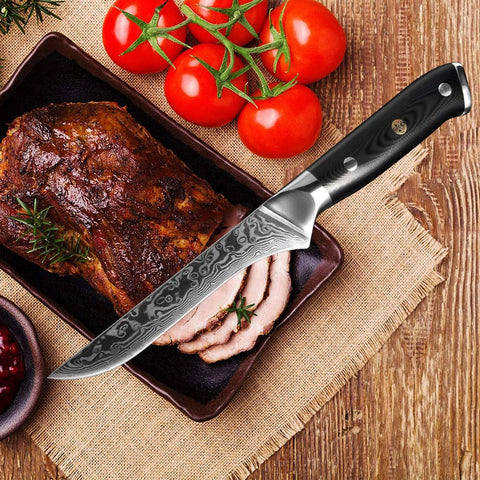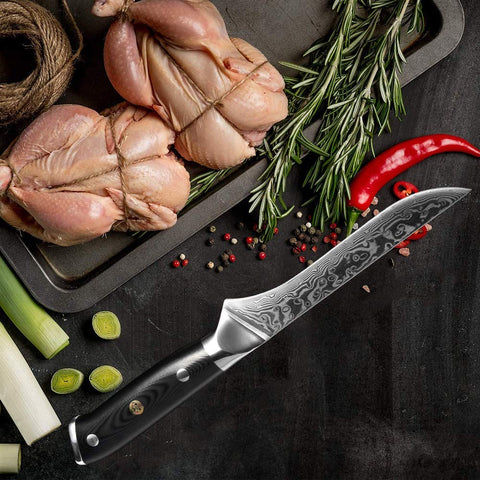This multi-purpose knife allows you to efficiently separate meat from bones, making your culinary experience smoother and more enjoyable. Whether you're preparing a hearty roast or simply enhancing your daily meals, this tool is designed to simplify your cooking process.
In this comprehensive guide, we’ll explore what defines a high-quality boning knife, the various types available, and how to select the perfect one for your kitchen. Additionally, we’ll highlight some exceptional options from SAKUTO Knives, renowned for their superior craftsmanship and elegant designs.

What Makes a Great Boning Knife?
A good boning knife combines sharpness, flexibility, and ergonomic design to ensure precision and ease of use. Here are some essential factors to consider:
Blade Material and Sharpness
A high-quality boning knife should have a blade made from premium steel that retains sharpness over time. Japanese Damascus steel, known for its durability and razor-sharp edge, is an excellent choice for this purpose.
Flexibility
Boning knives come in two primary types: flexible and stiff. Flexible blades are ideal for delicate tasks such as filleting fish, while stiffer blades are better suited for tougher jobs like deboning chicken or pork.
Handle Comfort and Grip
For accurate cutting, the handle should fit comfortably in your hand. Look for knives with ergonomically designed handles to ensure a secure grip and maximum control.
How to Choose the Right Boning Knife
When working with fish, opt for a flexible boning knife. However, for red meat or poultry, a stiffer knife is recommended due to its ability to provide more precise cuts.

Cutting Technique
To achieve clean cuts, hold the knife at a slight angle and use smooth, even strokes along the bone. This method minimizes waste and ensures efficient separation of meat from bones.
Maintenance and Sharpening
Regular honing is crucial to maintain the knife's sharpness, while sharpening should be done sparingly. Proper maintenance reduces the risk of accidents and ensures clean, efficient cuts.
Types of Boning Knives
Flexible vs. Stiff Boning Knives
Flexible boning knives are designed for delicate tasks, while stiffer knives excel in handling tougher cuts with ease and precision.
Curved vs. Straight Blades
Curved blades offer enhanced maneuverability when working around bones, while straight blades provide better control during precise slicing tasks.
Real-World Applications of Boning Knives
Filleting Fish
A flexible boning knife is ideal for filleting fish, allowing for smooth, effortless removal of flesh from bones.
Deboning Poultry
When preparing chicken or turkey for roasting or grilling, a stiff boning knife simplifies the process of bone removal, making it easier and more efficient.
Trimming Meat
For clean, high-quality cuts, use a boning knife to trim excess fat and sinew from large chunks of meat before slicing.
Promoting Quality Knives: Elevate Your Culinary Experience
For those seeking premium boning knives, SAKUTO offers an impressive range of options:
Gyuto Japanese Damascus Steel Knife with Colored Blue Handle
This knife boasts exceptional sharpness and features a stylish blue handle design, making it perfect for detailed cutting tasks.
Okugai Damascus Steel Kitchen Knife with Abalone Handle
Equipped with a unique abalone handle, this knife combines aesthetic appeal with practical functionality. The blade, crafted from Damascus steel, ensures unparalleled sharpness and durability.
Frequently Asked Questions (FAQs)
What's the difference between a boning knife and a fillet knife?
Boning knives are typically heavier and more robust, designed primarily for separating meat from bones. Fillet knives, on the other hand, are lighter and more flexible, specifically created for filleting fish.
How do you sharpen a boning knife?
You can sharpen a boning knife using a sharpening stone or a knife sharpener. Hold the knife at approximately a 20-degree angle and draw it evenly across the stone or through the sharpener on both sides.
Can I use a boning knife for vegetables?
Although possible, it's not ideal to use a boning knife on vegetables. Its thin edge tends to dull quickly when used on hard surfaces commonly found in vegetables.
What’s the best way to store a boning knife?
To preserve its sharpness and avoid accidents, store your boning knife in a knife block, on a magnetic strip, or within a protective sheath that covers only the blade while leaving the handle exposed.
How often should I hone and sharpen my boning knife?
Before each use, ensure the knife is properly honed. Sharpening should be done occasionally, perhaps every few months, depending on how frequently you use it.
Frozen Fish,Frozen Bonito Tuna,Frozen Mackerel Fish,Fresh Frozen Mackerel Fish
ZHEJIANG RETRONX FOODSTUFF INDUSTRY CO.,LTD , https://www.retronxfoods.com